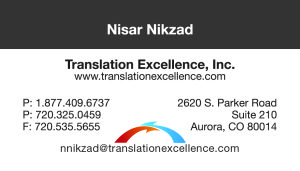
Are you a freelance translator or interpreter looking to buy business cards for the first time? Are you wondering if you should translate them into each language you offer? As with most business decisions, there are both advantages and disadvantages of producing your business cards in multiple languages.
To begin, if you do not already have business cards available to give out to current and prospective clients, consider using them. They are a great way to demonstrate professionalism, as they imply a certain level of forethought and investment. They are convenient for both you and the client and, depending on the layout and design, do not need to cost an exorbitant sum to produce. Upon deciding to use business cards, you may want to consider translating your information into the language(s) that you offer.
One reason you may want to hand out translated business cards is to demonstrate your linguistic competency. You will add a level of legitimacy to your business when you provide tangible evidence of your language abilities. In addition, translating your business cards into multiple languages can be helpful when working with a potential client who does not speak English; not only will they be impressed by the extra effort, but they will also feel more comfortable if the information with which you are providing them is written in their native tongue.
On the other hand, creating business cards in multiple languages can be time-consuming and potentially costly, so you must consider how you would go about producing them. If you most frequently translate between two languages, a convenient way to include both without creating two completely separate cards is to design double-sided cards featuring one language per face. If you are an English to Spanish translator, for example, your card would include your information in English on one side and the information in Spanish on the other. For those who translate among multiple languages, however, the solution is not quite as simple. If you wish to carry business cards for each language you offer and don’t see the double-sided card as an option, you could simply produce a stack of cards in each language, perhaps making fewer for those languages that you find to be less frequently required. This option is certainly more expensive, however, and you must weigh this cost with the aforementioned benefits of handing out language-specific cards.
There are many factors that could determine your decision to translate the information provided on your business card. Cost, efficiency, and convenience for both you and your client should all be taken into consideration when placing your next order. There is no “one-size-fits-all” solution, since each situation is different. As a freelance translator or interpreter, do you hand out business cards? If so, are they translated into each language you offer? We would love to read your thoughts and suggestions below!






